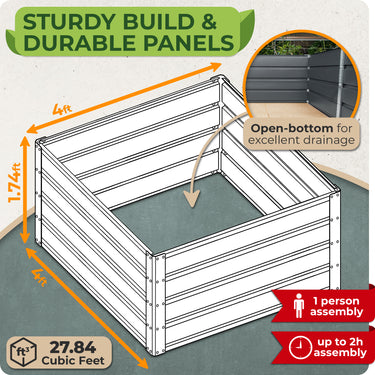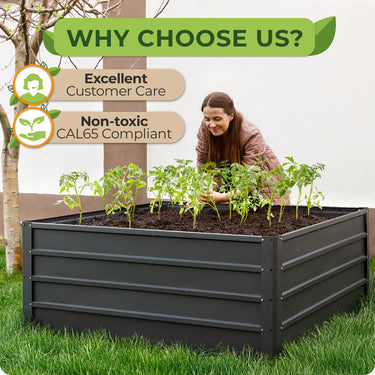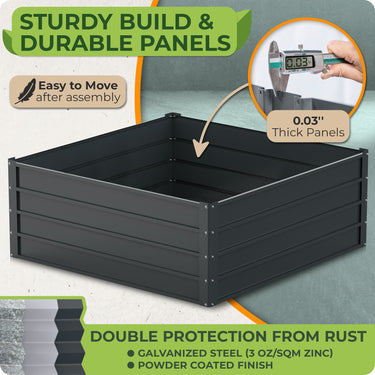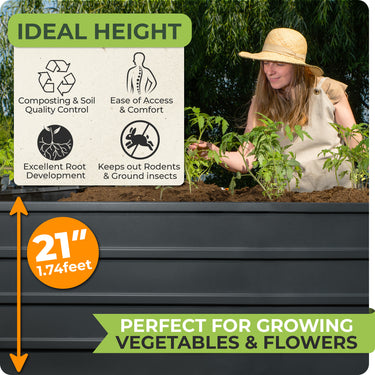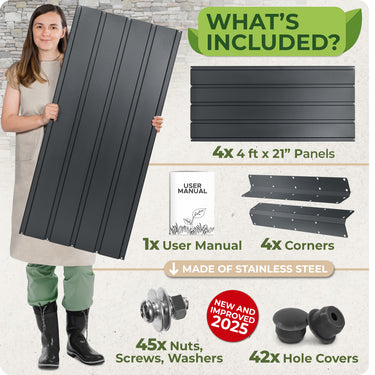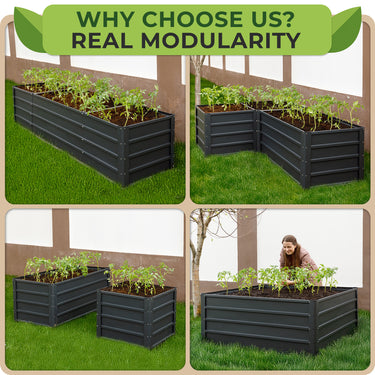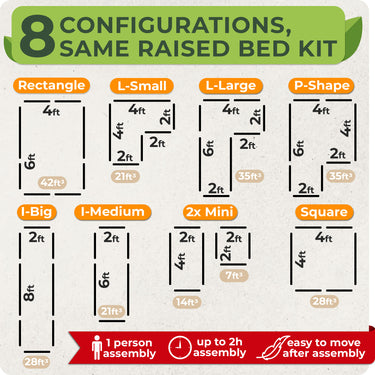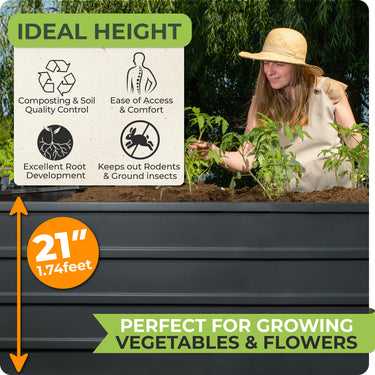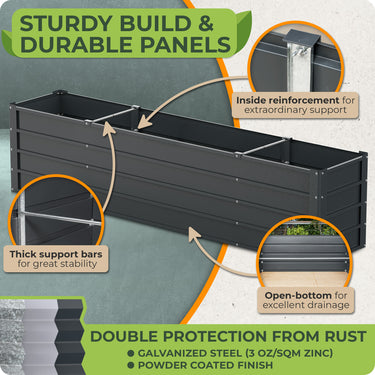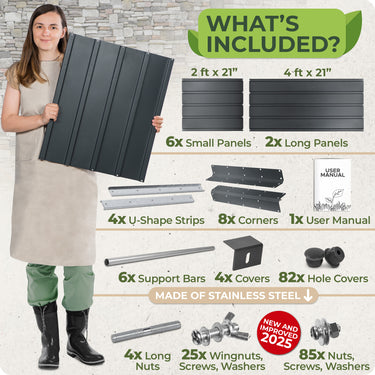
Photo source: Shutterstock.com
As the warm days of summer arrive, many gardeners eagerly anticipate the plentiful harvests this season promises. Summer garden plants have adapted to flourish in the intense sunlight and warm temperatures typical during this time. Many popular vegetables, including tomatoes, peppers, and squash, come from tropical and subtropical regions, where they've developed ways to handle heat and drier conditions.
These crops provide fresh, nutritious food and support local ecosystems. Additionally, many summer vegetables, with their bright flowers, attract pollinators and beneficial insects, which helps keep gardens and the surrounding areas healthy. Plus, growing summer plants connects people to old farming practices and the natural cycle of the seasons.
This guide explores the world of summer garden plants, from well-known favorites to new and interesting options. You’ll discover the best ways to pick, plant, and care for these warm-season crops, ensuring your garden thrives, even when it's hot. Whether you're an experienced gardener or just starting out, this article will give you the knowledge and ideas you need to create a productive summer garden!
Table of Contents
- What makes summer gardening unique?
- Choosing the best summer vegetables to grow
- Productive summer crops for a bountiful harvest
- Easy vegetables to grow in summer for beginners
- Fast growing vegetables in summer for quick summer harvests
- Planning and preparing your summer vegetable garden
- Summer garden plants beyond vegetables
- Maintaining your summer garden: watering and care tips
- Creative gardening ideas for summer
- Making the most of your summer garden bounty
What makes summer gardening unique?
Summer gardening has its own set of challenges and opportunities. The long days and strong sunlight mean many plants can grow quickly and produce a lot of fruit. Yet, these conditions also mean you need to pay close attention to watering and plant care.
One key thing about summer gardening is the need for varieties that can handle the heat. Plants that do well in summer have ways to deal with high temperatures. They might have deep roots, waxy coatings on their leaves, or the ability to stop growing temporarily when it gets too hot. For example, tomatoes have tiny hairs on their stems and leaves that help control their temperature and reduce water loss.
Water is very important in summer gardens. Because water evaporates faster and plants use more water, you need to water wisely. Many experienced gardeners use methods like watering deeply, using mulch, and choosing varieties that don't need much water. This helps them keep their gardens healthy without using too much water. Efficient watering methods, such as drip irrigation, ensure that plants receive the moisture they need directly at the root zone, minimizing water waste and promoting healthy growth.
Summer also brings specific pests and diseases. Warm temperatures can speed up the life cycles of many pests, causing them to multiply quickly. Similarly, some fungal diseases thrive in the humid summer weather. To succeed, summer gardeners need to watch out for pests and diseases and take action early. They often use integrated pest management, which works with the garden's natural environment.
Despite the challenges, summer gardening is very rewarding. You can grow a huge variety of crops during this season. From juicy tomatoes to crisp cucumbers and fragrant basil, summer gardens can offer many different flavors and textures. Often, you'll have extra produce to preserve by canning, freezing, or drying. That way, you can enjoy what you've grown even after summer is over.
Now that you know what makes summer gardening unique, let's explore how to select the best summer vegetables to grow for your specific needs.
Choosing the best summer vegetables to grow

Photo source: Shutterstock.com
Picking the right vegetables for your summer garden is the key to getting a good harvest. Think about your local climate, how much space you have, and what you like to eat. Some vegetables are a great fit for summer conditions and can be the basis of a successful warm-season garden.
Tomatoes are often seen as the ultimate summer crop. They come in many types, from small cherry tomatoes to large beefsteaks. Indeterminate tomatoes, which keep growing and producing all season, are a good option if you want a long harvest. If you live where summers are very hot, choose heat-tolerant types like 'Arkansas Traveler' or 'Solar Fire'.Peppers, both sweet and hot, are another popular choice for summer gardens. These relatives of tomatoes do well in warm weather and can produce a lot with the right care. Bell peppers are useful in many dishes, while hot peppers like jalapeños or habaneros can add spice to your meals. 'California Wonder' bell peppers and 'Jalapeño M' are reliable options for summer gardens.
Eggplants have attractive foliage and shiny fruit, making them a nice addition to the summer garden. Plants like this love heat and can produce plenty of fruit in warm weather. The classic Italian type 'Black Beauty' and the long, thin Asian type 'Ping Tung Long' are both suited for summer growing.
Summer squash, like zucchini and yellow squash, grows fast and produces a lot. These plants can start producing in about 50 days and keep going throughout the season. Bush types are good for smaller gardens, while vining types can be grown on trellises to save space.
Cucumbers have a crisp texture and refreshing flavor, which makes them a favorite summer vegetable. Vining types can be grown on trellises to save space, while bush types work well in containers or small gardens. If you live in a hot climate, look for heat-tolerant types like 'Ashley' or 'Armenian'.Beans, especially pole beans, can provide a steady harvest all summer. Beans add nitrogen to the soil and produce tasty pods. For example, 'Kentucky Wonder' pole beans and 'Dragon Tongue' bush beans are both good choices for summer gardens.
Productive summer crops for a bountiful harvest
Although many vegetables grow well in summer, some are especially productive. Summer crops like these can provide you with an abundance of fresh produce throughout the season, making them valuable for any garden during the warmer months.
Indeterminate tomatoes are known for producing a lot of fruit. Unlike determinate types that produce one main crop, indeterminate tomatoes keep growing and producing all season long. For example, 'Sun Gold' cherry tomatoes can produce hundreds of sweet, golden fruits from just one plant. Similarly, 'San Marzano' paste tomatoes produce a lot of flavorful fruits that are great for sauces and canning.
Okra, which loves heat and comes from Africa, can be very productive in warm climates. Once okra plants start producing, you can harvest them every day. New pods form quickly to replace the ones you pick. The 'Clemson Spineless' type is a reliable producer that stays tender even when it gets larger.
Summer squash, especially zucchini, is known for its high yields. One plant can produce several pounds of fruit during the season. 'Black Beauty' zucchini and 'Early Prolific Straightneck' yellow squash are both known for being highly productive.
Pole beans grow vertically and can produce many pods in a small area. The 'Kentucky Wonder' pole bean is a reliable type that can produce a lot of beans for weeks if you pick them regularly. For something different, 'Yard Long' beans can produce very long pods that are tender and flavorful.
Peppers can be very productive if they get enough water and nutrients. 'California Wonder' bell peppers and 'Serrano' hot peppers are both known for producing a lot. By picking peppers regularly, you can encourage the plants to keep producing throughout the season.
Eggplants, while not as productive as some other summer crops, can still provide good harvests. Not least, the 'Patio Baby' type is good for container gardens and can produce up to 50 fruits per plant. If you want larger fruits, 'Black Beauty' eggplant is a productive option.
If you're just starting out, you might be wondering which vegetables are the easiest to grow. Next, we'll cover some easy vegetables to grow in summer for beginners.
Easy vegetables to grow in summer for beginners
If you're new to summer gardening, it's best to start with vegetables that are easy to grow. These crops don't need a lot of attention and can still do well even if you make a few mistakes.
Bush beans are a great choice for beginners. These plants are small and don't need trellising. They also produce quickly, often giving you beans to harvest in 50-60 days. 'Provider' bush beans are known for being reliable and resistant to diseases, making them perfect for beginners.
Cherry tomatoes are usually easier to grow than larger tomatoes. They tend to resist common tomato problems and produce a lot of fruit even if you don't do much to care for them. 'Sweet 100' cherry tomatoes produce a lot and can grow in different conditions.
Summer squash, especially zucchini, is easy to grow and gives you a lot of vegetables. These plants grow fast and can start producing in just a few weeks. 'Black Beauty' zucchini is a classic type that's good for beginner gardeners.
Basil is a herb that does well in summer and is easy to grow. It goes well with many summer vegetables, especially tomatoes, both in the garden and in your cooking. Classic Genovese basil is a reliable choice that's hard to mess up.
Peppers, especially smaller types, can be a good choice for beginners. Bell peppers like 'California Wonder' are easy to grow and can be used in many dishes. If you like a little spice, jalapeño peppers are usually easy to grow and produce a lot.
Fast growing vegetables in summer for quick summer harvests
For those looking to see results quickly or dealing with a short growing season, fast-growing vegetables are an excellent choice. These crops mature rapidly, often providing harvests in just a few weeks.
Radishes are among the fastest-growing vegetables. Some varieties are ready to harvest in as little as 21 days. 'Cherry Belle' radishes grow quickly and produce crisp, round roots that are great in salads or as a snack. To extend your harvest season, plant new seeds every week or two.
Like we said before, bush beans are not only easy to grow but also produce quickly. Many types can be harvested in 50-60 days. 'Contender' bush beans mature early and give you a concentrated harvest, making them a good choice if you want a quick crop.
Summer squash, especially zucchini, grows fast and produces quickly. Many types can be ready to harvest in about 50 days. 'Early Prolific Straightneck' yellow squash lives up to its name, giving you fruits to harvest early and often.
Cucumbers, especially bush types, can produce fruits in 50-60 days. 'Spacemaster' bush cucumbers are small and mature quickly, making them good for small gardens or containers.
Leafy greens like arugula and leaf lettuce can be harvested as baby greens in just 21 days. You can also let them grow longer for full-sized leaves. Heat-tolerant types like 'Jericho' lettuce or 'Apollo' arugula can let you enjoy salads even in the warmer months.
Proper planning and preparation are key to a successful summer vegetable garden, so let's discuss how to plant a summer garden for success.
Planning and preparing your summer vegetable garden

Photo source: Shutterstock.com
To have a successful summer garden, you need to plan and prepare well. By taking the time to set up your garden properly, you can create an environment where your summer vegetables will thrive.
Start by looking at your garden area. Most summer vegetables need full sun, which means at least 6-8 hours of direct sunlight each day. Watch your garden during the day to see where the sunniest spots are. You might want to use structures or taller plants to provide shade in the afternoon for plants that don't like too much heat.
Preparing the soil is very important for summer vegetables, which often need a lot of nutrients. Start by testing your soil to see its pH and nutrient levels. Most vegetables prefer a pH that is slightly acidic to neutral (6.0-7.0). Add organic matter like compost or well-rotted manure to your soil as needed. This adds nutrients and improves the soil's structure and how well it holds water.
Plan your garden layout to meet each plant's needs. Tall plants like indeterminate tomatoes or pole beans should be placed where they won't block sunlight from shorter crops. Put plants that need the same amount of water together to make watering easier. Think about companion planting, like putting basil near tomatoes to keep pests away and improve the tomatoes' flavor.

Photo source: Carpathen.com
If you're looking to optimize your gardening setup, consider using raised garden beds. These can improve soil drainage and make gardening easier on your back, especially in areas with poor soil quality. Nursery pots and planters are also essential as they allow for easy mobility of plants and can be reused season after season.

Photo source: Carpathen.com
Set up a watering system before you start planting. Drip irrigation or soaker hoses are good options because they deliver water directly to the plant roots. This reduces water waste and prevents diseases on the leaves. Mulching around plants with organic materials like straw or wood chips can help the soil stay moist and keep weeds down. Using planters can help regulate moisture levels, ensuring plants get the right amount of water.
Prepare for pest control by planting a variety of plants that attract beneficial insects. Add flowering herbs and annuals throughout your vegetable garden to give pollinators and predatory insects a place to live and find food. Have organic pest control methods ready, like insecticidal soaps or neem oil, so you can deal with problems quickly if they arise. Nursery pots can be moved to protect plants from pests or unfavorable weather conditions.
Don't limit yourself to just vegetables; there are many other plants to grow in summer that can thrive in your summer garden.
Let's explore summer garden plants beyond vegetables! Incorporating a mix of planters and pots can add visual interest and allow you to experiment with different plant combinations.
Summer garden plants beyond vegetables

Photo source: Shutterstock.com
While vegetables are often the main focus in summer gardens, adding a variety of other plants to grow in summer can make your garden more diverse, attract beneficial insects, and make it more beautiful. Many flowering annuals, herbs, and even some perennials can grow well with your summer vegetables.
Marigolds are a classic companion plant for vegetable gardens. Their bright flowers add color, and their strong scent can help keep certain pests away. The 'Gem' series of marigolds, which are small and have edible flowers, are especially good for planting among vegetables.
Sunflowers have tall stalks and cheerful blooms. They can be used as natural supports for climbing beans or to create shade for plants that don't like too much heat. The 'Mammoth' type can grow very tall, while smaller types like 'Sunspot' are good for smaller gardens or containers.
Zinnias are annuals that are easy to grow and attract many pollinators, like butterflies and bees. Their blooms last a long time, come in many colors, and can be cut for bouquets without hurting the plant. The 'California Giant' mix has a wide range of colors and shapes.
Herbs like basil, cilantro, and dill not only give you fresh flavors for cooking but also attract beneficial insects to your garden. Letting a few plants flower can give pollinators a valuable source of nectar. 'Genovese' basil, 'Santo' cilantro, and 'Bouquet' dill are all reliable types that go well with summer vegetables both in the garden and on your plate.
Native plants can help support local ecosystems and also thrive in your summer garden. Plants like echinacea (coneflower) and rudbeckia (black-eyed Susan) bloom for a long time, attract pollinators, and make your garden more visually interesting. These perennials can be the foundation of a diverse and healthy garden ecosystem.
Now that you have a thriving summer garden, let's look at some essential watering and care tips to keep it that way for your summer gardening vegetables.
Maintaining your summer garden: watering and care tips
Proper maintenance is important for keeping your summer garden healthy and productive. As temperatures rise and plants grow the most, giving them the right care can make a big difference in how well they produce your summer gardening vegetables.
Watering is probably the most important part of summer garden care. Most vegetables need consistent moisture to produce well, but too much water can cause root problems and fungal diseases. Water deeply but less often to encourage roots to grow deep. Aim for about 1-1.5 inches of water per week, either from rain or watering. Water early in the morning to reduce evaporation and let the leaves dry before night, which can help prevent fungal problems.
Mulching is very helpful in summer gardens. A 2-3 inch layer of organic mulch around plants can help the soil stay moist, regulate the soil temperature, and keep weeds down. Straw, shredded leaves, or wood chips are good mulch materials for vegetable gardens. Add more mulch as needed throughout the season.
Regularly fertilizing is crucial for many summer vegetables, which often need a lot of nutrients. A balanced, slow-release organic fertilizer at planting time can provide a good start. For plants that need a lot of nutrients, like tomatoes and peppers, add a liquid fertilizer every 2-3 weeks during the peak growing season. Be careful not to over-fertilize, as this can cause the plant to produce a lot of leaves but not much fruit.
Pruning and training certain crops can improve airflow and how much they produce. Indeterminate tomatoes do better if you regularly remove suckers (the shoots that grow between the main stem and branches). Cucumbers and pole beans may need help climbing their supports. Pinching off the growing tips of basil and other herbs encourages them to grow bushier and delays flowering.
Check your garden regularly for signs of pests or diseases. Many problems can be handled effectively if you catch them early. Use integrated pest management, starting with the least harmful methods like picking off pests by hand or using row covers. If you need stronger methods, choose organic options like insecticidal soaps or neem oil.
Ready to get creative? Let's explore some innovative gardening ideas for summer that can transform your space.
Creative gardening ideas for summer
Summer offers many chances to be creative with how you garden. By thinking beyond the traditional row garden, you can make the most of your space, add visual appeal, and potentially increase your harvest.
Vertical gardening is a great way to maximize a small space. You can use trellises, arbors, and other supports to grow vining crops like cucumbers, pole beans, and even small melons. A living wall of edible plants can be both a productive garden and an attractive feature. Think about using repurposed materials like old ladders or pallets to create unique vertical growing structures.
Container gardening gives you flexibility and can be especially useful in cities or if you have trouble moving around. Many summer vegetables, including determinate tomatoes, peppers, and eggplants, can thrive in large containers. Try using unusual containers like grow bags, half barrels, or even old sinks or wheelbarrows. Make sure they have good drainage and use a high-quality potting mix.
Intensive planting methods like square foot gardening can greatly increase how much you grow in a small space. This involves dividing the growing area into small squares and planting each with a different crop at the right spacing. It's a good way to use companion planting and make the most of every bit of garden space.
Edible landscaping combines food-producing plants with ornamental garden designs. Try using colorful Swiss chard or frilly lettuce as border plants. Add dwarf fruit trees or berry bushes as focal points in your landscape. Edible flowers like nasturtiums or borage can add color and interest while also being tasty additions to summer salads.
With your garden flourishing, it's time to think about how to make the most of your summer garden bounty with these summer vegetables and summer garden plants.
Making the most of your summer garden bounty
As your summer garden produces the most it can, you may find you have a lot of fresh produce. To make the most of this, you should not only enjoy the fresh harvest but also preserve the extra for later from your summer vegetables and summer garden plants.
Harvesting properly can make many vegetables produce for longer. Pick often to encourage them to keep producing. Most vegetables should be picked in the morning when they are freshest. Use clean, sharp tools to avoid hurting the plants. Some crops, like indeterminate tomatoes and pole beans, will keep producing as long as you harvest them regularly and take care of them.
Preserving extra produce lets you enjoy your garden's harvest long after summer is over. Tomatoes can be canned whole, made into sauce, or dried. Peppers freeze well, either whole or chopped. Herbs can be dried or frozen in oil to make them easy to use in winter cooking. Cucumbers and beans can be pickled for long-term storage. Learning basic food preservation techniques can greatly increase how useful your garden harvest is.
Think about sharing your extra produce with friends, family, or local food banks. Many communities have programs that connect gardeners with people who need fresh produce. Organizing a neighborhood produce swap can be a fun way to get a variety of crops and build connections in your community.
Saving seeds from your best plants can help you keep successful varieties going and adapt them to your specific growing conditions over time. Focus on open-pollinated varieties, which will produce plants that are similar to the parent plant. The best way to save seeds varies by crop, so research the best methods for each type of vegetable you want to save.
Finally, take some time to think about your summer gardening experience. Take notes on what worked well and what problems you had. This information will be very helpful when you plan next year's garden. It will let you improve your techniques and choose better varieties for even greater success in the future.
When summer fades, the insights and techniques you've gathered will set the stage for future gardening endeavors. Take what you've learned this season to plan your next garden. Consider rotating crops to maintain soil health, and experiment with new varieties to discover what thrives in your unique environment. Dive deeper into food preservation methods, and perhaps even explore seed saving to cultivate your own adapted plant varieties.
Don't hesitate to share your knowledge with fellow gardeners. By exchanging tips, tricks, and even extra produce, you not only foster a sense of community but also contribute to a more sustainable and bountiful local food system. Remember! With each season, your garden becomes not just a source of food but also a testament to your dedication and a thriving ecosystem!










